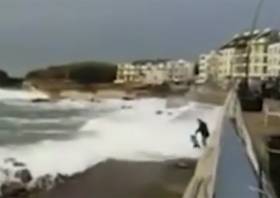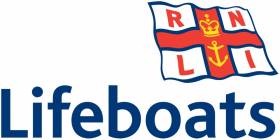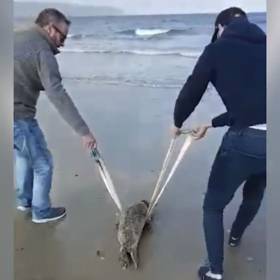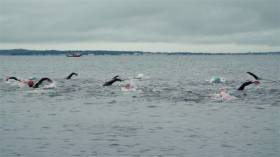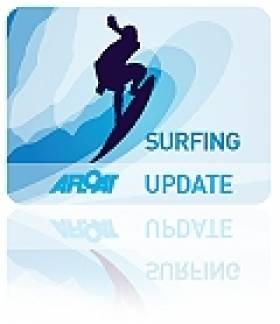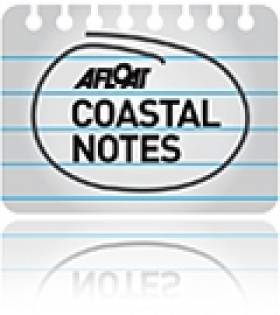Displaying items by tag: video
Video Shows Child Swept Off Feet By Wave On Irish Coast
#WaterSafety - The Irish Coast Guard has once again warned the public to stay back and say safe in coastal areas during severe weather after video emerged of a young child swept off their feet by a surprise wave.
Independet.ie has video of the recent incident in Portstewart on the North Coast, where a man and the child are filmed walking along the promenade as large waves lap over the edge at high tide.
Beachgoers Rescue Seal Pup From Co Down Strand
#MarineWildlife - Independent.ie has video of a seal pup being rescued by quick-thinking beachgoers in Co Down this week.
Aaron McLoughlin realised he had no phone signal to call for assistance when he and his wife Gemma and her family found the young seal stranded on the sand.
So he and his father-in-law David Lamont improvised a sling to lift the juvenile marine mammal out of danger and back into the water, as you can see in the clip below:
Galway Bay Swim 2016 Captured On Video
#GalwayBaySwim - Hello Deer Media was on hand to capture on video the tremendous effort on display at last weekend's Frances Thornton Memorial Galway Bay Swim.
As previously reported on Afloat.ie, more than 100 swimmers crossed Galway Bay from Auginish to Salthill on Saturday 23 July for the 11th annual open sea swim in aid of Cancer Care West.
Bird's Eye Views Of Ireland's Beauty From Lough Eske To Dublin Bay
#Drones - Filmmakers have been using consumer-grade drones to capture some stunning footage in recent times, and this incredible video of Lough Eske is no exception.
Spanish video company eldrone.es launched from the grounds of Solis Lough Eske Hotel in Donegal to capture the breathtaking beauty of the lake in glorious 4K quality.
Meanwhile, Irish Rail released a similarly sweeping aerial view of the recently refurbished Drogheda Viaduct, after €6.1 million of EU-funded works that saw the installation of a new drainage system, waterproofing and state-of-the-art lighting.
It's a fitting facelift for Sir John MacNeill's engineering marvel that has spanned the River Boyne for 160 years.
Aerial photographer Dennis Horgan may not use a drone for his vistas, opting for helicopters and fixed-wing aircraft to get in position for the right shot, but his latest images captured over Dublin Bay are all the more impressive for it.
Indeed, a number of Dublin's waterfront landmarks appear in TheJournal.ie's gallery of his bird's eye view of the capital, many seen from unusual angles.
Irish Student's 'Street Surfing' Video Goes Viral
#Surfing - An Irish wave enthusiast's 'surfing' video on the streets of Manchester has gone viral.
As the Belfast Telegraph reports, Manchester University student Sean-Caio Dos Santos Corr from Derrylaughan made the clip for the craic after spotting traffic splashing barrel waves onto the pavement on a flooded street.
Waiting for another downpour, Corr and his friend Christian Berger pounced with surfboard, camera and Bermuda shorts at the ready – and the results caught the interest of online viewers across Europe.
"We didn't even intend to take a camera with us we just grabbed it on the way out of the house for a laugh," says Corr.
"And now it's quite funny that people are actually interested in seeing eejits on the side of the road getting splashed in the face by a puddle."
In other surfing news, one of Cornwall's most prominent big-wave surfers has set up shop on Ireland's Wild Atlantic Way to be in prime position for the giant walls of water the current stormy season is bound to throw up.
Tom Lowe tells the Western Morning News how chasing the biggest and best waves for a living often means sleeping on friends' floors – and jetting around the world at a moment's notice - while keeping in peak physical and mental condition
“It’s a complete package," he says. "Your heart has to be in it, your mind has to be in it and you have to be physically stable.”
Winter Won't Deter The Irish Kitesurfing Project
#Kitesurfing - Raising awareness of this country's perfect conditions for wave-riding – and some of the best local practitioners of the sport – is the aim of a new video series by the Irish Kitesurfing Project.
As Surfer Today reports, the first clip showcases Robert Sayer, Wojciech Piotrowski and Alan Kavanagh braving the winter chill to show off their skills in some seriously strong surf. Here's looking forward to more from this exciting project!
Mullaghmore's Big Waves Focus Of New Surfing Video Series
#Surfing - The history of big wave riding at Mullaghmore is the focus of the latest episode of Threading Edges, the new surfing video series from EPIC TV.
As championed by JOE.ie, last week's first episode introduced a number of regular visitors to the Sligo monster describe what makes the swell so special.
But the second part delves more into the relatively recent history of the must-surf destination for the world's most extreme surfers – and one that's helped put Ireland squarely on the world surfing map.
Surf Meets Trad In New Video Tribute To Lahinch's Big Waves
#Surfing - Ireland's surfing scene gets another tribute in this new short film from surf-wear brand Billabong, via BreakingNews.ie.
Matching the pulsing rhythms of a trad session at Kelly's Bar with breathtaking action from the wild waves off Lahinch in Co Clare was an inspired choice for this clip, produced by the former title sponsors of the annual Big Wave Awards.
That's a contest with a local connection as Lahinch native Ollie O'Flaherty was nominated in 2012 for the massive swell he caught along with Mullaghmore regular Andrew Cotton.
This particular clip, however, features American Shane Dorian with Frenchman Benjamin Sanchis, a recent challenger for the biggest wave of all time, taking on the intimidating water walls of Aileens and Rileys.
Dunmore East In Focus In New Video Profile
#CoastalNotes - Online video channel IrishTV has turned its cameras on Dunmore East for the latest edition of Waterford County Matters – going out on the water with the local RNLI lifeboat for a training exercise, discussing seasonal trade with businesses in the popular seaside town and much more besides.


























